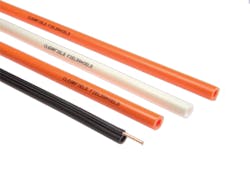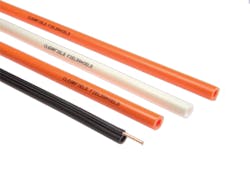Why bigger isn't always better for cabling installation projects
From the July, 2014 Issue of Cabling Installation & Maintenance Magazine
Microtechnology can help take fiber to new environments, often with greater effectiveness and lower costs than traditional installation methods.
By Cindy Olson, Clearfield Inc.
The need for high bandwidth and high-speed transmission is upon us and increasing every day. Today's wireless-device users are hungrily consuming bandwidth at a rate never experienced before. Then there's video streaming along with countless devices and applications burning up the bandwidth and capacity. And every service provider is feeling the pressure as their networks are overloaded, speeds are moving at a turtle's pace and frustrated customers are complaining.
According to the latest report from the Cisco VNI Global Mobile Data Traffic Forecast, global mobile data traffic grew 81 percent in 2013-but networks have not kept up with this pace. What's more, mobile network connection speeds more than doubled in 2013 with no end in sight. The need for service providers to satisfy all the wireless technologies and mobile devices along with the endless use of applications, high-speed Internet, video streaming, etc., is becoming increasingly challenging. The countless bandwidth-burning devices and apps that are being developed and released almost every day are driving an explosion that demands increased capacity in every type of network.
Additionally, as anyone involved in the telecommunications industry already knows, "wireless" communication involves plenty of "wires"-or fiber bandwidth and infrastructure to support the explosion in demand. These dynamics are forever shifting the process of how fiber networks are being deployed, maintained and expanded, and it points squarely that these additions and increases must be simpler and easier to deploy and maintain. While this may be a seemingly straightforward statement, it's anything but a straightforward problem. Service providers across the country are searching for simple solutions and they are left struggling with all the complex choices among the various products, technologies and installation methods available. There are dozens of trade articles and white papers written on traditional fiber installations versus blown-fiber installations, along with costs associated. These articles have accompanying financials marketed to back up the method preferred. This has made the choices and decisions all the more difficult for any service provider considering expanding their network. Service providers are hungering for simpler, easier choices. Where do they start?
What's in it for the service provider?
As mentioned earlier, there are an astounding number of products and technologies offered in our industry today for deploying fiber cable. Some of these technologies are proprietary in nature and even patented. Some require a significant upfront investment in highly specialized equipment and in-depth training. Some are disruptive to deploy, such as open trenching or boring. Many of these options offer and include a 25-year extended end-to-end warranty, or promise a simple resulting architecture and deferred costs. While all of this can seem attractive in one way or another, depending on what is required, the hook with most of these offerings is the commitment from the service provider. In order to be the recipient of any of the above, end-to-end warranties require that end-to-end infrastructure be purchased from this company too. Many do not realize this includes all fiber connectivity, such as junction boxes, enclosures, panels, frames, wall boxes, hubs, cabinets, pedestals, jumpers, cable assemblies-even the fiber cable itself before a warranty will be granted and issued.
Additionally, the service provider's installation crew must be fully trained and certified by the company providing the warranty. The question of whether these methods save anything in the way of time or cost is difficult to measure, and sometimes cannot be verified until you've gone "all in."
So how can a service provider make economically sound decisions on which direction to go, and realistically plan fiber deployments without adversely affecting the bottom line? And once started, if the results are not what was expected, what options are available?
For service providers, an easy cost-effective method to deploy and install fiber infrastructure appears to be more difficult due to the dizzying array of choices. While some technologies are very viable for certain optimum conditions like greenfield applications, many would have you believe that only two options-traditional fiber-installation methods and blown fiber-installation methods-exist for deploying fiber. There is another solution that has been regarded as simple and cost-effective.
Microtechnology in fiber
That other solution is microtechnology, which in addition to being simple and cost-effective, also is adaptable to fiber deployment in all kinds of conditions. Thanks to the latest advancements in microtechnology, fiber cable has made big strides in alleviating and accommodating the ever-increasing demands for bandwidth. Microtechnology fiber and duct is quickly becoming a favorite choice for even the most complex fiber deployments because of how easy and cost-effectively it is installed and maintained.
Moreover, service providers must keep pace with the demand for more capacity in order to satisfy their customers' needs and increase their revenue by developing new fiber and accompanying bandwidth. Typically this will create new installation and routing obstacles that must be overcome. Conduits and ducts are filling up fast and the existing paths are becoming unavailable at a pace not before seen in the industry. The race is on to use any leftover space that remains.
One significant challenge is how to get the fibers into these spaces. Many times, any remaining space in a conduit cannot be used by traditional installation methods with traditional fiber. Think about a duct almost completely filled with cable going straight up the side of a cell tower. A thick outside-plant (OSP) fiber cable is the last thing the tower owner will allow. Unfortunately, options already are limited for where blown fiber and associated equipment can be deployed, and it is not an option when the existing conduit pathway is even partially filled.
All this cabling and congestion makes it very difficult for technicians and installers to gain access to existing fiber, and even harder to install new fiber. Then add the building owners, city planners and engineers who have been asked repeatedly for access. Many now take a position that they are not willing to allow any new open trenching or disruptive construction for more pathways and ducts in their buildings, streets and sidewalks. Open trenching and digging up streets again and again to install more conduits is becoming increasingly tricky and frowned upon, as the streets get overpopulated with yet more conduit and pipe routes. This phenomenon has even caught the attention of the Federal Communications Commission (FCC); under FCC consideration is the possibility of mandatory sharing of ducts and conduits if there are empty tubes left behind after a deployment is complete. The outcome is yet to be determined, however this points to the epidemic proportions reached in the realm of conduits and ducts.
Effectively using microtechnology
All this news can weigh heavily on service providers, until they discover an easier way. Microfiber cable and microducts can expand service providers' networks. Microduct and micro distribution fiber cable save significantly on costs, installation time and restoration, while also saving precious space even in nearly full conduits and ductwork without interrupting the pathways' existing fiber. Around corners and over pipes, pushable/pullable fiber technology offers the flexibility and adaptability that service providers are searching for to increase capacity in wireless towers, high-rise buildings, housing developments and neighborhoods. When used in conjunction with microducts, it provides a rugged solution that can be deployed just about anywhere with little or no disruption-including pushed up an antenna tower, hung aerial on a strand of wire, or microtrenched into the ground.
Microcable and microduct can be deployed under almost any condition in almost any type of path, with no expensive specialized equipment required. With fiber counts from a single strand in 3mm outside diameter (OD) for desktop or single-family home deployments, to 24 fibers in a microsized 4.5mm OD fiber cable for MDU, customer premises or data center deployments, microcable is ready for a wide range of deployment scenarios. With microduct technology, open trenching to plow-in traditional OSP fiber can be a thing of the past, as microducts can be microtrenched in streets and alleys with little impact on the infrastructure.
Microfiber and microduct technology are innovative alternatives for service providers in today's demanding environment. With the ability to reach new environments and meet rugged standards with minimal impact, these technologies have given service providers the means to solve critical space constraints and cable-routing challenges while offering significant labor and cost savings.
Cindy Olson is a senior product and market manager for Clearfield Inc. (www.clearfieldconnection.com).

